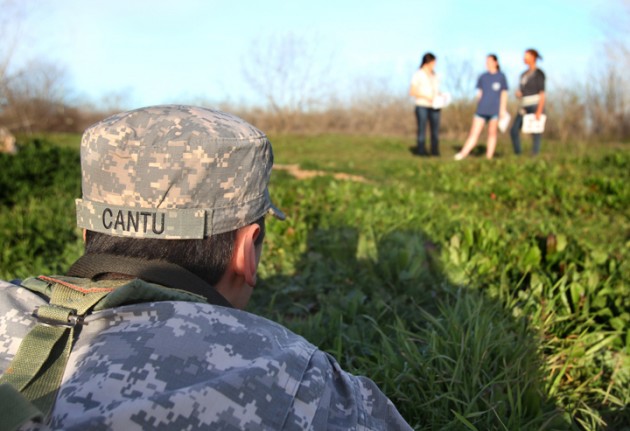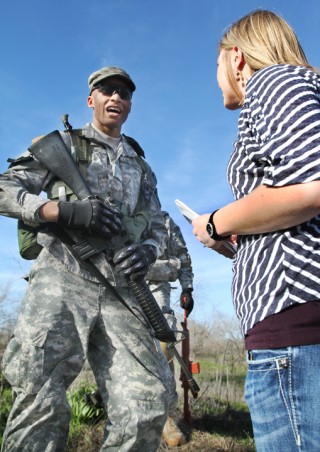

Matt Hellman | Lariat Photo Editor

Matt Hellman | Lariat Photo Editor
By Meghan Hendrickson
Reporter
They’re trained in combat, in discipline, in dress and … in talking to reporters?
Baylor Army ROTC cadets were trained in dealing with the media on Thursday.
Fidel Gomez, senior military science instructor for the Media on the Battlefield course, said he wanted cadets to learn how to deal confidently with reporters in the midst of war.
“There’s no way you can be in the military and not interact with the media at some time,” said Hackettstown, N. J., senior Brian Crookshank, who serves as the primary instructor for the Media on the Battlefield lab.
Nearly 100 cadets arrived Thursday at Bear Field, the 28 acres of Baylor-owned land located on University Parks Drive beside the Willis Family Equestrian Center, for their weekly training lab. Upon their arrival they were greeted by a group of journalism students from Dr. Brad Owens’ Public Relations for Non-profit Organizations class.
The journalism students devoted a few hours toward the Army ROTC’s training by acting like professional reporters covering a battle overseas.
“A lot of the cadets have never done anything like this before and there are guidelines that they need to follow that are easy in principle, but hard to actually follow in process,” Crookshank said.
The Colony senior David McLain acted as one of the journalists and said he was interested in seeing how the Army approaches media today.
“It’s going to be fun to watch the Army ROTC attempt to act in a real-life situation and see how they react to something a little bit uncomfortable,” McLain said on the field before the mission took place.
While the cadets were being briefed on the day’s mission by their instructors, Gomez briefed the journalists on their roles. A set of credentials and a list of interview questions were provided for each journalist to use as a springboard for their encounters with the cadets.
Denver, Colo., junior Mark Cerf was questioned by three journalists while also trying to accomplish the mission assigned to his platoon and maintain operational security.
“It’s very rare that we actually get outside influence, especially from people in the media or potential media profession, to come in and help us out with training,” Cerf said. “Every time we come out here it’s a great learning experience, and honestly one of the best ways to learn, because sometimes we mess up and make mistakes.”
Although this was just training, the instructors said they wanted the cadets to react to the media in a realistic way.
“The best thing I can do for these cadets is provide that realism – the realistic environment – and that’s one thing that we’re so fortunate that Baylor has,” Gomez said. “We’re not in some gym, we’re not in some ballpark, we’re actually coming out here and the cadets feel like they’re in a real training environment.”
The cadets agreed the training was relevant to their future whether they choose to serve in the Army or in a civilian career.
“In this modern age, we have reporters everywhere – the world’s a lot smaller,” Cerf said. “We really need to put our best foot forward and show them what the Army really is all about.”
Gomez said he hopes to have journalism students help out with this training again in the years to come because he felt it was such a success.





